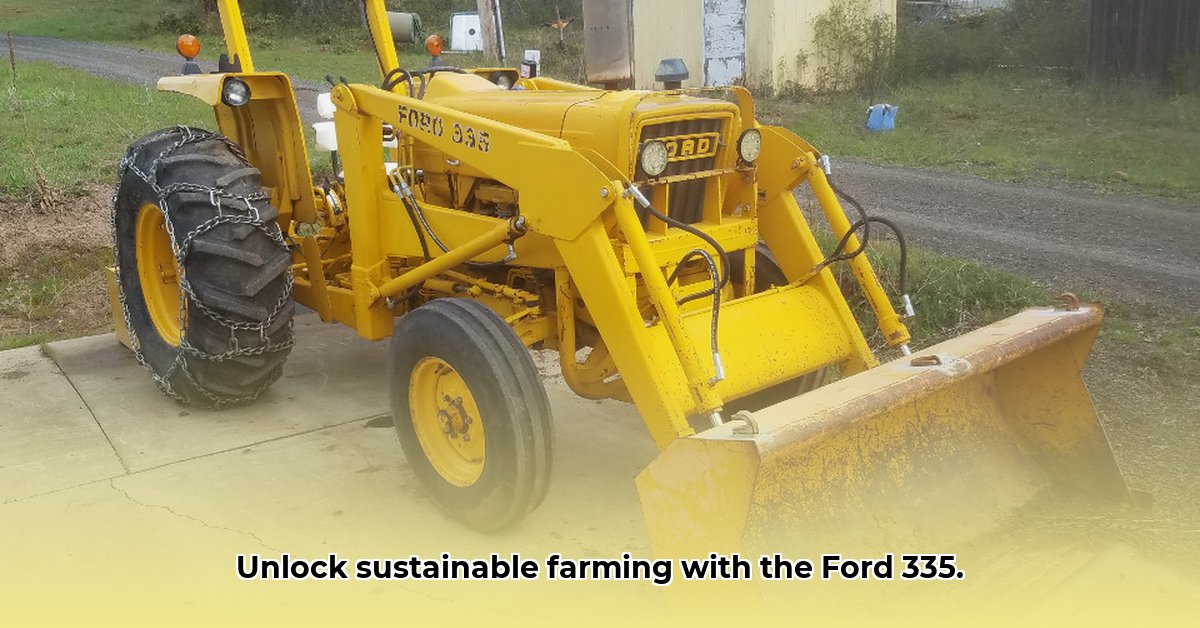
The Ford 335: A Historical Overview
The Ford 335, a stalwart of mid-20th-century agriculture, holds a significant place in farming history. Produced from [Insert Production Years Here], this tractor represents a pivotal era in agricultural mechanization. For more information on finding a Ford 335, check out this helpful resource: Ford 335 for sale. This guide provides comprehensive specifications and analysis, exploring its suitability for modern sustainable farming practices.
Detailed Specifications: Unveiling the Ford 335's Capabilities
The following table details the specifications of the Ford 335 tractor. Note that some values require further verification from original documentation and might vary slightly based on specific model variations.
| Specification | Value | Notes |
|---|---|---|
| Engine Type | 3-cylinder Diesel/Gasoline | Fuel type varied depending on the model and year of production. |
| Engine Displacement | 2.8L | Based on widely reported specifications, though confirmation through original manuals is recommended. |
| Horsepower | ~43.8 hp | This value represents an average; horsepower output could slightly vary depending on specific model and maintenance condition. |
| Transmission Type | 6-speed or 8-speed | The number of speeds differed according to individual model variations. Original manuals will clarify the specific configuration. |
| Fuel Capacity | Approximately 13 gallons (49.2 liters) | This is an approximate value based upon several sources; further verification from official documentation is needed. |
| Wheelbase | Approximately 80.3 inches (203 cm) | This measurement shows consistency across multiple sources, but verification with original documentation remains advisable. |
| PTO Type | Requires Clarification | Further research into specific model variations is essential to verify the Power Take-Off (PTO) type. |
| Tire Sizes | Requires Clarification | Tire sizes varied based on model and configuration; original specifications need to be confirmed. |
| Weight | Requires Clarification | Weight varies depending on configuration. Original documentation will provide exact values. |
| Dimensions (L x W x H) | Requires Clarification | Significant discrepancies exist across different sources; further research is needed to accurately determine the dimensions (Length x Width x Height). |
| Lift Capacity | Requires Clarification | Further investigation is required to determine the exact lift capacity. Consult original service manuals. |
Performance & Capabilities: A Comparison to Modern Standards
The Ford 335, while powerful for its time, pales in comparison to modern tractors in terms of horsepower and advanced features. Its relatively low horsepower (approximately 43.8 hp) limits its suitability for large-scale operations. However, its straightforward mechanical design contributed to its reliability and ease of maintenance for smaller-scale tasks. Its lack of advanced features like GPS guidance and sophisticated hydraulic systems is offset by its simplicity and ease of repair. This simplicity can be a significant advantage for smaller farms, educational institutions, or those prioritizing mechanical understanding over technological sophistication.
Sustainability Considerations: Environmental Impact and Economic Viability
The Ford 335's sustainability must be considered within the context of its time. While its relatively small engine likely offered better fuel efficiency than some larger contemporary tractors, this efficiency is still lower compared to modern, fuel-efficient agricultural machinery. Its weight—while potentially lower than modern tractors—needs further clarification to properly assess its contribution to soil compaction. This is a major concern in sustainable agriculture, as excessive soil compaction impacts soil health and crop yield. Maintaining a Ford 335 requires access to specialized parts and skilled maintenance. Parts availability presents a significant challenge. The cost of restoration and maintenance needs careful consideration against the economic viability this tractor provides in modern farming practices.
Practical Applications & Use Cases: Finding the Right Niche
Despite its age, the Ford 335 finds relevance in specific niches:
- Small-Scale Farming: Its compact size and manageable power make it suitable for tasks on smaller farms or hobby farms.
- Educational Purposes: Educational institutions use it to demonstrate the history and evolution of agricultural technology.
- Specialized Tasks: Its simplicity and maneuverability could prove beneficial for specific tasks in niche agricultural contexts that don't demand high horsepower.
Maintenance & Restoration: Preserving a Piece of History
Maintaining and restoring a Ford 335 requires specialized knowledge and resources. Sourcing parts might require contacting specialized suppliers or joining online communities of vintage tractor enthusiasts. Common repair issues include engine problems, hydraulic leaks, and electrical malfunctions. A good understanding of vintage mechanical systems is crucial in effectively maintaining this older machine. Restoring a Ford 335 is often a labor of love, requiring patience, mechanical aptitude, and access to original parts or suitable replacements.
Conclusion: A Legacy of Reliability
The Ford 335, though a product of its time, serves as a valuable testament to the progression of agricultural technology. While its capabilities are limited compared to modern tractors, its simplicity, robust design, and potential for use in sustainable small-scale farming and educational settings ensure its lasting legacy in agricultural history. Its continued relevance highlights the enduring value of reliable, manageable machinery, even within the context of advanced technological developments in modern agriculture.